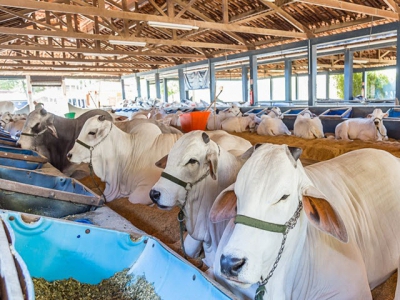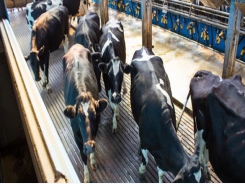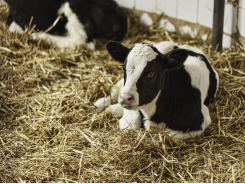Feedlot cattle: Functional oils may improve feed intake during abrupt transition

Swapping in-feed antibiotic use for functional oils may support the weight gain, performance and meat quality of feedlot raised cattle, say researchers.
Photo © GettyImages/paulobaqueta
A team of researchers from Brazil explored the use of functional oils (FO) in place of antibiotics with cattle receiving a concentrate-based diet.
The group published its work in the journal of Animal Feed Science and Technology.
“We hypothesize that this FO blend could replace conventional antibiotics and decrease the risk of metabolic disorders in cattle fed high-concentrate diets preserving without negative effects on animal performance, carcass traits and meat quality.
“This study aimed to investigate the efficiency of these additives to avoiding ruminal and metabolic disorders, following an abrupt transition to a high-concentrate diet in feeding for Bos indicus (Nellore) cattle raised in pasture system with low performance and body weight, a common situation in Brazilian beef cattle production.”
During the feeding trials, the researchers found that cattle receiving diets with a blend of functional oils had higher dry matter intake than those on a diet supplemented with monensin and virginiamycin during the transition period, they said.
During the feedlot period, cattle on the blend had better intake than cattle receiving the monensin and virginiamycin diet or a feed with 30mg/kg dry matter (DM) monensin.
“The abrupt transition to high concentrate diets did not affect performance and blood parameters,” they said. “The FO did not cause negative effects on performance, carcass traits and meat quality, compared to conventional additives for finishing Nellore cattle in [a] feedlot.”
Why functional oil use?
Feed additives are commonly used in beef cattle diets to boost performance, lower production costs and improve profits, the researchers said.
The ionophores monensin and virginiamycin have been widely used as additives to improve growth, average daily gain, energy use and the gain to feed ratio while reducing disease.
However, there has been increasing interest in reducing the use of antibiotic products from a concern about bacterial resistance to antibiotics and possible consequences for human health, they said.
Instead, plant extracts and functional oils are being considered as feed additives to replace the use of “conventional additives.”
“The improvement in performance of cattle in feedlot is essential to provide economic success due to the high costs in feeding industry,” they said. “Therefore, the inclusion of a fast diet is important to improve ADG and G:F (Zotti et al., 2017), specially for Brazilian feedlots that feed cattle for short periods (70–100 days).”
In past research, a high monensin concentration (400mg/kg DM) and functional oils did not alter ruminal metabolism, they said. But, a monensin level of 300mg/kg DM lower acidosis during the transition period.
However, there is little information evaluating the use of alternative feed additives like functional oils on meat quality, carcass traits and performance in Bos indicus cattle, the researchers said.
Methods and materials
During the feeding trial, 48 cattle received one of four supplemented diets, the researchers said.
The diets included a basal feed with a range of additives including 30mg/kg DM monensin (M30), 40mg/kg DM of monensin (M40), 30mg Monensin and 25mg Virginiamycin/kg DM (MV), or 400mg/kg DM of functional oils (FO) – castor oil and cashew nut shell liquid.
“The animals were fed a ground corn-based diet with an 8:92 forage (sugarcane bagasse):concentrate ratio on a dry matter (DM) basis,” they said. Cattle received the diets for a 120 day period, they added.
Dry matter intake (DMI) and body weight (BW) were checked on days 1, 7, 14 and 21 then every 21 days through the end of the feeding period in addition to blood samples being collected for analysis, they said.
The average daily gain (ADG) and gain to feed ratio (G:F) were calculated.
Feeding behavior also was noted on days 27, 56 and 92, they added.
Feed samples were collected on 21-day intervals and analyzed for crude protein (CP) and ether extract (EE), while neutral and acid detergent fiber (NDF and ADF) and total digestible nutrient (TDN) were established, the researchers said.
Muscle tissue and backfat thickness were checked at the start and end of the feeding period.
Rumen fluid was collected at the end of the trial and the rumen was checked for signs of rumenitis, they said.
Cattle livers also were checked for abscesses at the end of the study and hot carcass weight (HCW), internal fat amounts along with initial and final carcass temperature and carcass pH were recorded.
Muscle samples also were collected after harvest to check for color, cooking loss, fatty acid muscle profile and tenderness, they said.
Results
Overall, dry matter intake and dry matter intake as a percentage of body weight during the trial was higher for cattle receiving the diet with added functional oils than for those on the MV diet, said the researchers.
However, results were similar to cows on the M40 diet.
No negative effects were found by day 21 of the trial from the rapid change in diet at the start of the trial, they added.
Results for average daily gain, the gain to feed ratio and final body weight were similar for cattle on all diets, they said.
The net energy (NE) for maintenance and gain, however, were higher in animals getting the MV diet.
“There was an effect of additive type on the ingestion rate as measured as kg of DM/ingestion time,” the researchers said. “The M30 and MV treatments had lower scores compared to M40 (P < 0.05), but the FO treatment was similar to the others.”
However, rumen pH, hepatic abscesses and occurrences of rumenitis were not altered by any of the feed additives, they said. “In the same way, additives had no effect on the most carcass traits, except for internal fat, where FO had higher values when compared to the M30 and MV, but did not differ from M40,” they added.
Meat color and percentages of saturated fatty acids, monounsaturated fatty acids and polyunsaturated fatty acids also were similar for cattle on all the diets, they said.
“However, the MV treatment had higher concentration of 15:0 and 17:0, 17:1, 18:1 t10, t11, t12 and 18:2, t10, c12 fatty acids,” they added.
Source: Animal Feed Science and Technology
Authors: A. dos S. Silva, C. Zotti, R. Carvalho, R. Corte, N. Cônsolo, S. da L. e Silva, P. Leme
Có thể bạn quan tâm
Phần mềm

Phối trộn thức ăn chăn nuôi

Pha dung dịch thủy canh

Định mức cho tôm ăn

Phối trộn phân bón NPK

Xác định tỷ lệ tôm sống

Chuyển đổi đơn vị phân bón

Xác định công suất sục khí

Chuyển đổi đơn vị tôm

Tính diện tích nhà kính

Tính thể tích ao hồ




 New app validated for conducting electrocardiograms on horses
New app validated for conducting electrocardiograms on horses  Proper feeding of calves … it begins with…
Proper feeding of calves … it begins with…